
Europe and Mediterranean: Italy, Greece and Croatia Cruise
Norwegian Cruise Line
Come aboard the newest and most innovative ship, Norwegian Viva, and experience the best of Italy, Greece and Croatia. Nestled on the west coast of Tuscany, charming Livorno offers the freshest seafood, awe-inspiring forts and splendid coastal views with ample cafes and boutiques awaiting your discovery. Game of Thrones fans will enjoy a tour of Dubrovnik's Old Town where several historic sites were featured in the hit TV show. Then journey from Split to the ancient village of Salona to explore Roman ruins and tour the Medieval architectural treasures of Trogir — a UNESCO World Heritage Site.

Executive Member Benefit
Executive Members receive an annual 2% Reward, up to $1,250, on qualified Costco Travel purchases
Digital Costco Shop Card
Member Exclusive: Digital Costco Shop Card with every Norwegian Cruise Line sailing†
Onboard the Norwegian Viva
Norwegian Viva
Year Built: 2023
Double Occupancy Capacity: 3215
Introducing the all-new Norwegian Viva, the next stunning ship in a brand-new Prima Class, designed to live life to the fullest. Stay connected to the ocean with extraordinary experiences that bring you closer to the horizon, unwind in the most spacious accommodations to date and experience first-rate service so you can live it up every second.
Activities & Services (included in cruise)
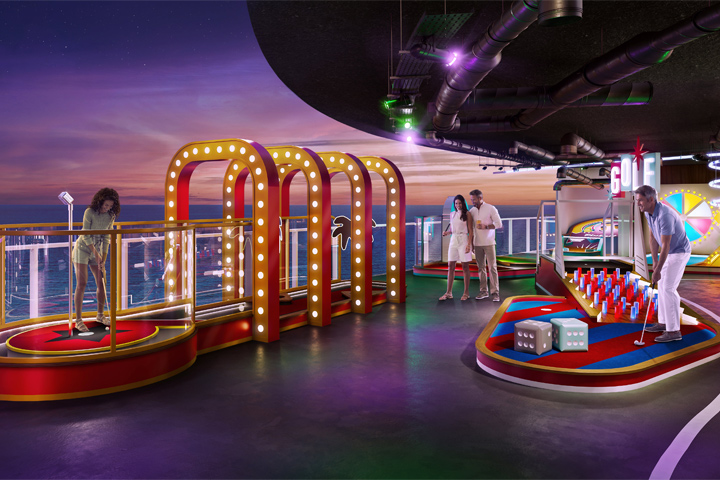
Miniature Golf
- Card Room
- Casino
- Disco/Nightclub
- Game Arcade
- Movies
- Theater/Show Lounge
- Comedy Club
- Fitness Center
- Miniature Golf
- Pool - Children's
- Pool - Outdoor
- Sports Facilities
- Art Gallery
- Bars/Lounges
- Internet Center
- Library
- Children's Indoor Play Area
- Organized Age Specific Activities
- Teen Center or Disco
- Teen Programs
- Business Center
- Concierge Desk
- Elevators
Activities & Services (available for an extra fee)
- Beauty Salon
- Fitness Classes
- Full-Service Spa
- Spa Services/Massage
- Sauna/Steam Room
- Dry Cleaning/ Laundry Service
- Duty-Free Shops/Boutiques
- Infirmary/Medical Center
- Safe Deposit Boxes
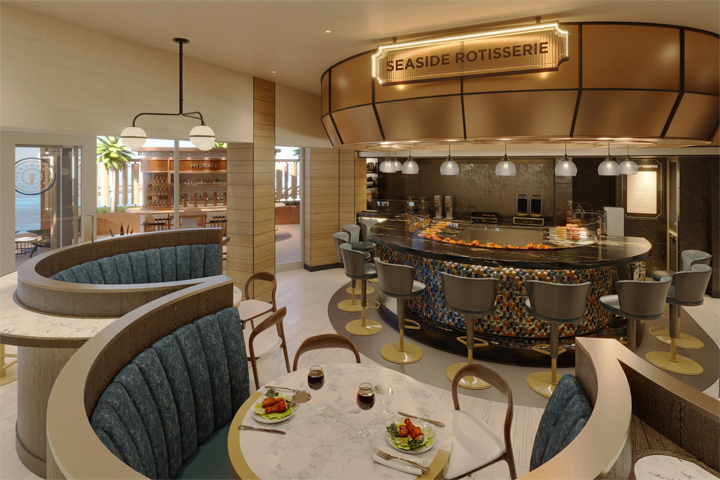
Seaside Rotisserie
Specialty Dining
Coco's: Visit the sweetest spot on the ship and indulge in your favorite chocolate temptations, including truffles, ice cream, pralines, and much more. This restaurant is available for an additional cost.
Los Lobos: Bienvenido a Los Lobos, a premium Mexican restaurant celebrating traditional flavors with a modern twist. From Carne Asada marinated in guajillo chiles and tequila to Tres Leches Cake with Coconut Cream, the chefs at Los Lobos focus on unique flavor combinations. (Seating on Ocean Boulevard available.) This restaurant is available for an additional cost.
Nudls: Noodle fans rejoice! From Thai to Italian, Chinese, and more, Nudls brings you the best of noodle dishes from around the world. This restaurant is available for an additional cost.
Onda by Scarpetta: Onda, or "wave" in Italian, brings the charm and effortless elegance of its critically acclaimed sister restaurant, Scarpetta, to sea. Uncork your favorite bottle of wine and let la dolce vita (the good life) flow. Indulge in a modern Italian culinary experience from Scarpetta's signature pasta like the famous Spaghetti Tomato & Basil to unique, mouthwatering seafood creations. And leave room for dessert. Sharing is optional. (Seating on Ocean Boulevard available.) This restaurant is available for an additional cost.
Q Texas Smokehouse: Dig into mouth-watering barbecue short ribs, chicken, brisket, and classic southern breakfast dishes at our Texas smokehouse. This restaurant is available for an additional cost.
Starbucks Kiosk: Whether you're craving a Caramel Macchiato, Teavana® Iced Green Tea Lemonade, or Cappuccino, stop by Starbucks for your favorite morning or afternoon beverage. This restaurant is available for an additional cost.
Seaside Rotisserie: Savor a wide range of rotisserie-style meats cooked to perfection over a spit. This restaurant is available for an additional cost.
Tamara: Spice up your day or evening with a wide variety of classic Indian dishes offered at Tamara. This restaurant is available for an additional cost.
The Garden: Go green at the Garden where we can customize your salad with the freshest ingredients, or you can order one of our delicious premade combinations. This restaurant is available for an additional cost.
Tapas Truck: Before you siesta, enjoy a fiesta of flavors infused into these Latin American tapas. This restaurant is available for an additional cost.
Casual Dining
The Haven Restaurant: Savor an exclusive array of dishes for breakfast, lunch and dinner in a private restaurant serving the finest cuisine. Enjoy stunning vistas indoors or al fresco (exclusively for guests of The Haven.)
The Local Bar & Grill: Located on Ocean Boulevard by Infinity Beach, The Local will warmly welcome you with its beach club atmosphere and live music. So come toast the good life with your favorite frozen cocktails while enjoying incredible views and a variety of culinary delights. (Seating on Ocean Boulevard available.)
Room Service: Available 24-hours a day, simply pick up the phone and order breakfast, lunch, dinner, or late-night munchies. A room service fee of $9.95 will be added to your check (except continental breakfast until 10 a.m. and Suite guests at all times). A 20% gratuity and beverage service charge will be added to your check.
Disclaimer regarding ship dining
This stateroom offers two lower beds that convert to a queen-size bed and two pullman beds.
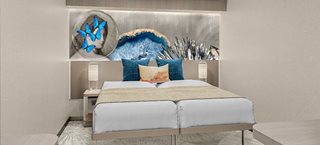
Category: I4
Accommodates 4, total approximate size 160 sq. ft
An affordable family option, these staterooms offer many of the same amenities as an Oceanview and include two lower beds that convert to a queen and two Pullman beds.

Category: IA
Accommodates 2, total approximate size 160 - 254 sq. ft
These Inside Staterooms are the most affordable way to cruise. They include two lower beds that convert to a queen, perfect for two guests to rest and recharge.

Category: IB
Accommodates 2, total approximate size 160 - 254 sq. ft
These Inside Staterooms are the most affordable way to cruise. They include two lower beds that convert to a queen, perfect for two guests to rest and recharge.

Category: IF
Accommodates 2, total approximate size 160 - 254 sq. ft
These Inside Staterooms are the most affordable way to cruise. They include two lower beds that convert to a queen, perfect for two guests to rest and recharge.

Category: IX
Accommodates 2, total approximate size 160 sq. ft
A Sailaway Inside stateroom guarantees an Inside stateroom or better! Your stateroom may be on any deck and assigned between time of booking up to one day prior to embarkation.

Category: IT
Accommodates 1, total approximate size 160 - 251 sq. ft
These staterooms include a queen-size bed and the same amenities as other inside staterooms. Staterooms are priced exclusively for solo travelers and include access to the private Studio Lounge.
These staterooms offer clear views of the ocean, two single beds that convert to a queen-size bed, and a private bathroom.

Category: O4
Accommodates 4, total approximate size 235 - 370 sq. ft
Perfect for families, these staterooms include two lower beds that convert to a queen, a double sofa bed to accommodate two more and a window offering beautiful views. Some also can connect to other staterooms for even more options.

Category: OA
Accommodates 2, total approximate size 235 sq. ft
These spacious staterooms are perfect for two guests to stretch out and relax, featuring a window with beautiful views and two lower beds that convert to a queen. Some can connect to other staterooms, too.

Category: OB
Accommodates 2, total approximate size 186 sq. ft
Enjoy the great views from your window and two lower beds that convert to a queen. Some of these comfortable staterooms can connect, so you can stay close yet spread out. Sleeps up to two.

Category: OX
Accommodates 2, total approximate size 186 sq. ft
A Sail Away Oceanview stateroom guarantees an Oceanview stateroom or better! Your stateroom may be on any deck and assigned up to one day prior to embarkation.

Category: OT
Accommodates 1, total approximate size 186 sq. ft
These staterooms feature a large round window and a queen-size bed. Staterooms are priced exclusively for solo travelers and include access to the private Studio Lounge.
These staterooms include two lower beds that convert to a queen-size bed and additional bedding for up to 2 guests.
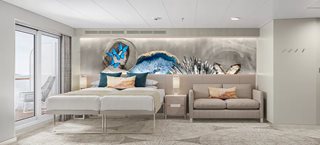
Category: B1
Accommodates 4, total approximate size 268 sq. ft, balcony size 102 sq. ft
These stylish Balcony staterooms are ideal for up to four guests. They include two lower beds that convert to a queen, some with a double sofa bed, spacious bathroom and are located aft, so the view from your private balcony is stunning. Some can connect to other staterooms, perfect when traveling with family or friends.

Category: B4
Accommodates 4, total approximate size 231 sq. ft, balcony size 45 sq. ft
These Balcony staterooms are perfect for the whole family. With room for up to four guests, they include two lower beds that convert to a queen, a double sofa bed, spacious bathroom, plus a balcony to admire the sparkling waters and beautiful vistas together. Some can connect to other staterooms so you can spread out yet stay close.
Note: Cabins 10300, 10900, 11300, and 11900 have a partially obstructed view.

Category: BA
Accommodates 2, total approximate size 231 - 358 sq. ft, balcony size 45 - 69 sq. ft
Balcony staterooms include two lower beds that convert to a queen, a sitting area, and floor-to-ceiling glass doors that open onto a private balcony offering amazing views. Some can connect to other staterooms, perfect when traveling with family or friends.
Note: Cabins 9218, 9818, 10816, 12212, 12812, 13810, 15798, 16192, and 16792 have a partially obstructed view.

Category: BB
Accommodates 2, total approximate size 231 - 358 sq. ft, balcony size 45 - 69 sq. ft
Balcony staterooms include two lower beds that convert to a queen, a sitting area, and floor-to-ceiling glass doors that open onto a private balcony offering amazing views. Some can connect to other staterooms, perfect when traveling with family or friends.
Note: Cabins 9218, 9818, 10816, 12212, 12812, 13810, 15798, 16192, and 16792 have a partially obstructed view.

Category: BF
Accommodates 2, total approximate size 231 - 358 sq. ft, balcony size 45 - 69 sq. ft
Balcony staterooms include two lower beds that convert to a queen, a sitting area, and floor-to-ceiling glass doors that open onto a private balcony offering amazing views. Some can connect to other staterooms, perfect when traveling with family or friends.
Note: Cabins 9218, 9818, 10816, 12212, 12812, 13810, 15798, 16192, and 16792 have a partially obstructed view.

Category: BX
Accommodates 4, total approximate size 231 sq. ft, balcony size 45 sq. ft
A Sailaway Balcony stateroom guarantees a Balcony stateroom or better! Please note that the view from your balcony may be fully obstructed or partially obstructed. Your stateroom may be on any deck and assigned up to one day prior to embarkation.

Category: BT
Accommodates 1, total approximate size 231 - 358 sq. ft, balcony size 45 - 69 sq. ft
These spacious staterooms include a queen-size bed, sitting area and floor-to-ceiling glass doors that open onto a private balcony. Staterooms are priced exclusively for solo travelers and include access to the private Studio Lounge.
Suites offer a comfortable bedroom, a living area and a private balcony.

Category: MX
Accommodates 2, total approximate size 241 sq. ft, balcony size 75 sq. ft
A Sailaway Club Balcony Suite guarantees a Club Balcony Suite or better! Please note that the view from your balcony may be fully obstructed or partially obstructed. Your stateroom may be on any deck and assigned up to one day prior to embarkation.

Category: MB
Accommodates 2, total approximate size 241 - 271 sq. ft, balcony size 75 sq. ft
These stylish Club Balcony Suites are forward-facing and offer the ideal retreat for two guests. They include two lower beds that convert to a queen plus a balcony to marvel at the ever-changing views. Some can connect to other staterooms, perfect when traveling with family or friends. Due to potential high wind speeds at the front of the ship, this cabin features solid metal bulwarks (railings) and/or glass windscreens.

Category: MA
Accommodates 2, total approximate size 265 - 291 sq. ft, balcony size 45 - 52 sq. ft
These stylish Club Balcony Suites are located at the back of the ship and offer the ideal retreat for two guests. They include two lower beds that convert to a queen plus a balcony to marvel at the ever-changing views. Some can connect to other staterooms, perfect when traveling with family or friends.

Category: M4
Accommodates 4, total approximate size 252 - 291 sq. ft, balcony size 46 - 62 sq. ft
Everyone will enjoy these spacious, stylish Club Balcony Suites located at the back of the ship. They feature two lower beds that convert to a queen, a double sofa bed and a private balcony to soak in the magnificent views. Some of these Suites can connect to other staterooms, perfect for family or friends to spread out yet stay close.
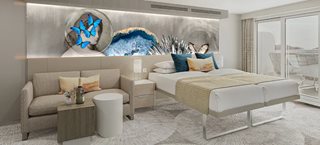
Category: M2
Accommodates 2-4, total approximate size 358 - 412 sq. ft, balcony size 129 - 185 sq. ft
With plenty of room for up to four guests, these Club Balcony Suites feature two lower beds that convert to a queen, some with a single or double sofa bed, spacious bathroom, and a sliding glass door that leads to a forward-facing balcony offering spectacular views. Due to potential high wind speeds at the front of the ship, this cabin features solid metal bulwarks (railings) and/or glass windscreens.
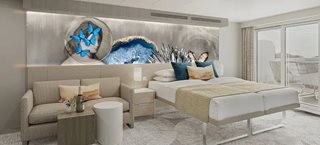
Category: SL
Accommodates 4, total approximate size 393 - 434 sq. ft, balcony size 129 sq. ft
An ideal retreat for the whole family, these Suites feature two lower beds that convert to a queen, a double sofa bed, plus a forward-facing balcony offering stunning views. Round out your picture-perfect family vacation with the indulgence of butler and concierge service.
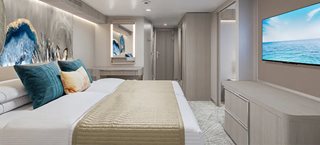
Category: SK
Accommodates 4, total approximate size 412 - 487 sq. ft, balcony size 153 - 191 sq. ft
Stunning views are straight ahead from the large, private balcony of these forward-facing, luxury Suites, perfect for up to four guests. Includes a separate bedroom with two lower beds that convert to a queen, a double sofa bed, spacious bath, and butler and concierge service for the ultimate getaway. Due to potential high wind speeds at the front of the ship, this cabin features solid metal bulwarks (railings) and/or glass windscreens.
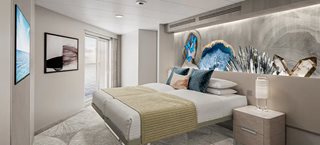
Category: SJ
Accommodates 4, total approximate size 388 sq. ft, balcony size 45 sq. ft
Perfect for the whole family, these Suites are located mid-ship and have plenty of room to spread out. They feature a separate bedroom with two lower beds that convert to a queen, a double sofa bed and spacious bath. Includes butler and concierge service, too.
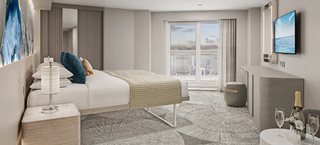
Category: SI
Accommodates 2, total approximate size 448 sq. ft, balcony size 195 sq. ft
There is plenty of room for you to relax and take in the gorgeous views from the aft-facing balcony of these stylish Suites. Featuring two lower beds that convert to a queen, they can connect to a Club Balcony Suite, perfect for family or friends to spread out yet stay close. Includes butler and concierge, too.
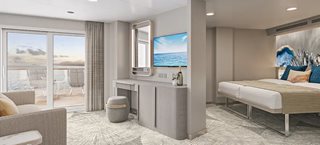
Category: SH
Accommodates 4, total approximate size 635 sq. ft, balcony size 370 sq. ft
Marvel at the unparalleled views from the large, aft-facing balcony of these spacious, stylish Suites featuring two lower beds that convert to a queen and a double sofa bed. They also include butler and concierge service. Perfect for up to four guests to indulge in a picture-perfect vacation.

Category: HE
Accommodates 2-3, total approximate size 368 - 418 sq. ft, balcony size 84 - 134 sq. ft
These luxury Penthouses have access to The Haven amenities and feature a king-size bed, some with bedding to accommodate one more, luxury bath with jetted shower plus a sitting area and a large balcony to admire the gorgeous views. Includes butler and concierge service for the ultimate luxury vacation.
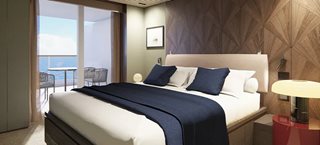
Category: HB
Accommodates 2-4, total approximate size 496 - 599 sq. ft, balcony size 129 - 220 sq. ft
Located in the exclusive enclave of The Haven, retreat to your luxury Penthouse that features a master bedroom with king-size bed and an aft-facing balcony offering awe-inspiring views. Some cabins contain a double sofa bed. Also includes the indulgence of butler and concierge service. (ADA stateroom does not have a separate bedroom.)
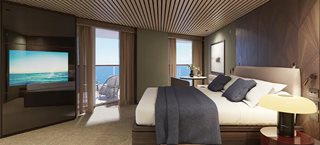
Category: HA
Accommodates 2, total approximate size 830 sq. ft, balcony size 498 sq. ft
Enjoy sophisticated style and luxury in this aft-facing, spacious Penthouse with a large balcony offering incredible views from the back of the ship and an outdoor hot tub. Features include a king-size bed, luxury bath with jetted shower and access to exclusive amenities for guests of The Haven. Butler and concierge service provide the finishing touch.
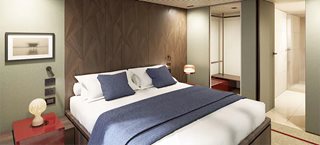
Category: H6
Accommodates 6, total approximate size 606 - 658 sq. ft, balcony size 138 - 190 sq. ft
These Villas located in The Haven provide the ideal luxury retreat for the whole family. They feature two bedrooms, one king-size bed, one queen-size bed, a double sofa bed, two bathrooms with jetted showers, and a large balcony to gather together and enjoy the beautiful views or snuggle under the stars. Plus, access to The Haven amenities and butler and concierge service to complete your picture-perfect vacation.
Note: Cabins 13900, 14300, 14900, 15300, and 15900 have a partially obstructed view.
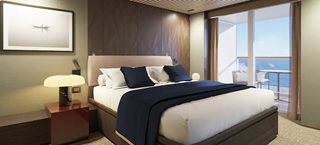
Category: H5
Accommodates 4, total approximate size 541 - 614 sq. ft, balcony size 109 - 132 sq. ft
Retreat to your sumptuous private oasis in The Haven Owner's Suite, featuring a separate bedroom in most with king-size bed, a double sofa bed to accommodate two more, living area, luxury shower and a large balcony to gather together and enjoy the beautiful vistas. Butler and concierge service round out your incredible getaway.
Please note: Staterooms 12322 and 12926 do not have a separate bedroom or bathtub.
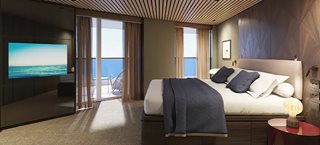
Category: H4
Accommodates 4, total approximate size 974 - 994 sq. ft, balcony size 527 - 535 sq. ft
Located in the exclusive enclave of The Haven, these luxury Owner's Suites feature a stylish master bedroom with king-size bed, a double sofa bed to accommodate two more, luxury bath with jetted shower and incredible views from the large, aft-facing balcony, some with an outdoor hot tub. Plus, a concierge and 24-hour butler to tend to your every wish. * Suites on deck 10 (10352 and 10952) do not include the outdoor hot tub.

Category: H3
Accommodates 6, total approximate size 1,607 - 1,749 sq. ft, balcony size 613 - 732 sq. ft
Marvel at the magnificent views from the aft-facing balcony of your luxury Deluxe Owner's Suite located in The Haven. Featuring a separate living and dining area, they also include two bedrooms with king-size beds, two luxury baths with jetted showers, a half-bath, additional bedding to accommodate six total guests and an outdoor hot tub. Butler and concierge service complete your vacation of indulgence.

Category: H2
Accommodates 8, total approximate size 2,100 sq. ft, balcony size 828 sq. ft
Located in The Haven, these stunning Suites offer breathtaking views from the large, aft-facing balcony. They feature spacious and luxurious accommodations that include separate living and dining areas, three bedrooms with king-size beds, a double sofa bed, three bathrooms with jetted showers, a half-bath, an outdoor hot tub and the indulgence of butler and concierge service to tend to your every want.
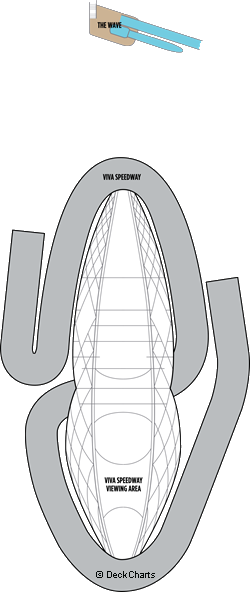
| Symbol | Description |
|---|---|
 | Stateroom with facilities for the disabled |
 | Connecting staterooms |
 | Third-person occupancy available |
 | Third- and/or fourth-person occupancy available |
 | Third-, fourth- and/or fifth-person occupancy available |
 | Up-to-sixth-person occupancy available |
 | Elevator |
 | Restroom |
 | Inside stateroom doors open to center interior corridors |
 | To be announced |
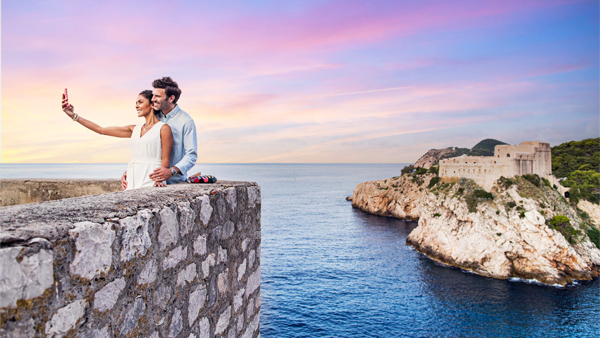
- Ship Name: Norwegian Viva
- Year Built: 2023
- Year Entered Present Fleet: 2023
- Ship Class: Prima Class
- Maximum Capacity: 4,012
- Number of Passenger Decks: 20
- Number of Crew: 1,388
- Ocean-View without Balcony: 124
- Total Inside Staterooms: 383
- Tonnage (GRT): 142,500
- Capacity Based on Double Occupancy: 3,215
- Country of Registry: The Bahamas
- Total Staterooms: 1,644
- Suites with Balcony: 1,137
- Crew/Hotel Staff Nationality: International
Costco Member Reviews

Terms & Conditions
*Price shown is per person based on double occupancy and is valid for select stateroom categories only. Click on the Terms & Conditions link below for details.
†One Digital Costco Shop Card per room/stateroom, per stay. The exact amount of the Digital Costco Shop Card will be calculated during the booking process. The Digital Costco Shop Card promotion is nontransferable and may not be combined with any other promotion. A Digital Costco Shop Card will arrive by email approximately 10 days after the start of your cruise. Click on the Terms & Conditions link below for additional information.
Ship's registry: The Bahamas
Images are an artist's rendering.
Digital Costco Shop Card
Book this vacation or cruise with Costco Travel and receive a Digital Costco Shop Card. The Digital Costco Shop Card is a convenient payment option in our warehouses and on Costco.com.







